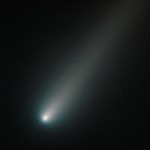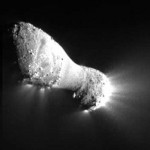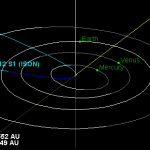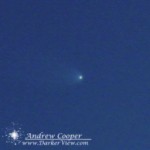Astronomers, professional and amateur alike, are getting ready for comet C/2012 S1 ISON, possibly the highlight of a year that has already seen several good comets.
Discovered in September 2012 by Vitali Nevski and Artyom Novichonok, of the ISON project, a group of telescopes dedicated to discovering and tracking solar system objects. The comet was then an 18th magnitude object in the outer solar system, an impressive find for a small telescope.

The next surprise was hinted at by the orbital calculations. The orbital solution indicated a nearly hyperbolic path, suggesting that this was a new comet, one that had not visited the inner solar system before. This possibility was strengthened by later observations of the comet.
The discovery of a sun-grazing comet more than a year ahead of perihelion is quite rare. The combination of a dynamically young comet and a sun-grazer offers a unique opportunity for astronomers. The comet represents a sample of the primordial solar system, a leftover building block of the planets. Orbiting far from the Sun this object is unaltered by passage through the inner solar system. As the comet will pass so close to the Sun this fresh material will sublimate and become visible to the many instruments directed at the comet.
For amateur astronomers the comet offers good observing. The intense heat expereinced by a sun-grazing comets will liberate enormous quantities of ice and gas to form the coma and tail. The result is often quite spectacular, a brilliant comet with a large tail sweeping across the sky. There is no guarantee of how the comet will appear, but there is promise enough for sky watchers to take notice and plan for pre-dawn observing sessions.

As the comet nears the warmth of out Sun the ices begin to sublimate, transforming into gas that jets off the body of the comet, taking great quantities of dust and small rock with it. It is this expanding cloud of gas and dust that makes a comet so visible. Indeed, even with powerful telescopes the nucleus of the comet remains hidden. We had no good photographs of a comet until several spacecraft visited comet Halley in 1986.
Brightness predictions for comets are notoriously unreliable. As my friend David Levy once remarked “Comets are like cats; they have tails, and they do precisely what they want.” A pointed reminder to take magnitude predictions for comets with a large degree of caution.
Much depends on the structure of the comet and what happens as it is subjected to the heating and gravitational stresses of perihelion. There is a fair chance the comet may come apart. These objects form in the microgravity environment of the early solar system. You may take the dirty snowball analogy one step further to explain that comets are poorly packed snowballs, liable to fall apart. Many comets do come apart, fragmenting into many smaller parts. Comet 73P/Schwassmann–Wachmann is a dramatic and recent example of this.
If the comet does disintegrate it may suddenly flare in brightness as fragmentation may release a great deal of dust and gas. Astronomers are split on the fate of comet ISON. Several have predicted that the comet will fragment, others believe it will survive perihelion passage. We will just have to watch and see.
In any case it is safe to say this comet will be bright enough to see without optical aid, always a treat. As alwats a dark sky will dramaticallt enhance the view. A little optical aid will also be useful. Given the size of a comet and tail it is low power instruments that will work best, binoculars and rich field telescopes. Instruments with a field of view of a few degrees.


At closest approach the comet will be less than a degree from the Sun, difficult to pick out. An observers best bet will be as it approaches and as it moves away from the solar disk. As the comet nears perihelion it will approach the Sun from the west, best seen in the dawn sky. After perihelion it will exit the Sun’s vicinity to the north, favoring northern hemisphere observers.
The question remains… What will we get? Comet C/2012 S1 ISON could be spectacular, a blaze of light across the dawn sky for all to see. The comet could become a modest comet requiring some optical aid to fully appreciate, either binoculars or a small telescope. Whatever comet ISON provides it should be worth the effort to get out and observe. Comets are always enjoyable!

